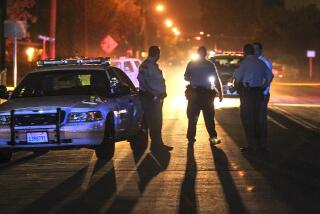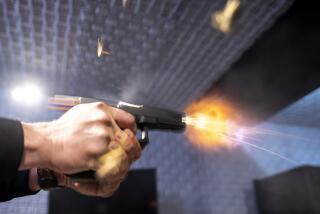Editorial: ‘Microstamping’ technology could help police crack down on gun crimes — if the gun lobby allows it
When someone shoots up a neighborhood with a semiautomatic weapon, the shooter usually leaves evidence behind — not only the bullets fired, but also the spent casings ejected from the gun as a fresh round loads. Ballistics experts can match distinctive marks the firing process leaves on the bullets and the casings against fresh samples fired from a gun that investigators believe may have been used in the crime. But first, of course, they must have the gun.
But there’s another technological solution that can help investigators connect spent casings to the gun that fired them: microstamping, a process in which a gun’s firing pin and what’s known as its breech face stamp an identifying code on the casing as the gun is fired. And under the California Crime Gun Identification Act, a 2007 state law that finally went into effect in 2013, all new semiautomatic handguns sold in California must be equipped with microstamping technology so that recovered casings can be traced to the gun’s last recorded buyer through the state’s database of gun sales.
That doesn’t necessarily mean the gun buyer was the shooter, of course, but it gives investigators a trail to pursue. And it also makes it easier for investigators to link casings from different crime scenes to the same gun, discerning patterns and connections that might otherwise be missed.
But only California requires microstamping technology today, which has led gun manufacturers to simply stop selling new semiautomatic handgun models in the state. That has effectively negated California’s law; according to the state Attorney General’s office, there are no new models with microstamping technology on its list of handguns certified as safe for sale. Clearly, a nationwide requirement is needed to compel gun makers to adopt the identifying technology. U.S. Rep. Xavier Becerra (D-Los Angeles) and Sen. Edward M. Kennedy (D-Mass.) proposed just such a law in 2008, but the measure died in committee.
Pro-gun groups have challenged the Crime Gun Identification Act in court, arguing that it prevents people from buying firearms that are in “common use,” a right the U.S. Supreme Court established in its (wrongly decided) 2008 Heller ruling. But U.S. District Judge Kimberly Mueller in Sacramento was correct when she ruled last year that Heller did not establish a right to buy just any firearm, and that California gun buyers still have hundreds of options to choose from. The pro-gun groups have appealed that decision, which also upheld a state ban on sales of cheap unsafe handguns (so-called Saturday Night Specials).
The gun lobby, of course, has a right to its day in court. But rather than trying to block sensible laws that help police without impeding anyone’s ability to buy a firearm, the gun lobby should work with gun-rights advocates to require microstamping technology nationwide on all semiautomatic weapons, including rifles (which were left out of California’s law to gain political support from pro-hunting legislators). In addition to making it easier to trace guns used illegally, microstamping poses a disincentive to those who might legally buy a gun and pass it on to someone barred from possessing a firearm, since any shots fired from the gun can bring police to the buyer’s door. It helps separate criminals from law-abiding gun owners. But then, the gun lobby has never been susceptible to reason.
Opponents argue that microstamping is bad because it isn’t perfect — studies have found that the microstamps on casings are legible only 54% to 88% of the time. But even at the lowest success rate, a little more than half of the shell casings recovered from a crime scene could be traced to the unknown gun that fired them, which is a lot better than none.
Separately, the federal Bureau of Alcohol, Tobacco, Firearms and Explosives already maintains the National Integrated Ballistic Information Network of ballistics tests on casings found at crime scenes. It’s a slower, more laborious process to match scratches and other unique markings left on casings to the guns that fired them, and unfortunately relatively few police departments contribute ballistics samples or consult the network. But federally required microstamping technology combined with a more robust ballistics database would give investigators nationwide a valuable tool for curbing gun crimes, and consequently improve public safety, without infringing on individual rights. Becerra and gun-safety advocates should work together to push this issue in the next Congress.
Follow the Opinion section on Twitter @latimesopinion or Facebook
More to Read
A cure for the common opinion
Get thought-provoking perspectives with our weekly newsletter.
You may occasionally receive promotional content from the Los Angeles Times.






